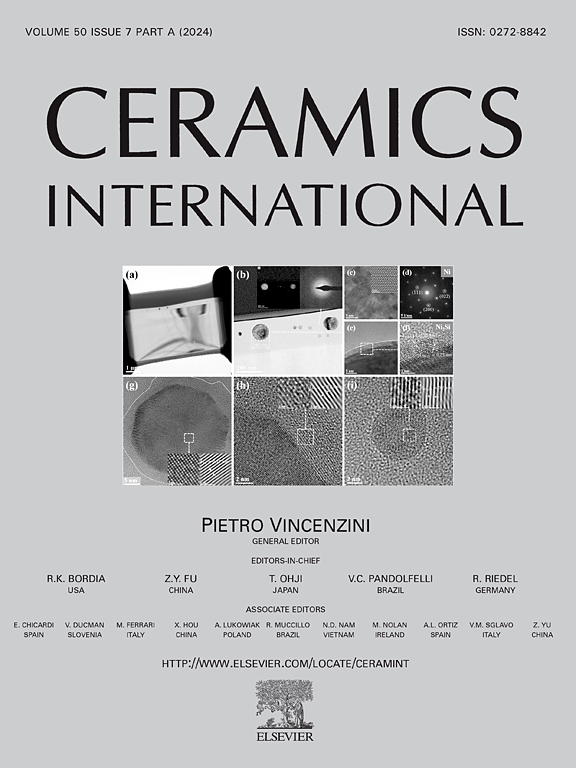Tuning color and solar reflection performance for Cr doped YAlO3 red pigment by multiple ions co-doping based on defect engineering
IF 5.6
2区 材料科学
Q1 MATERIALS SCIENCE, CERAMICS
引用次数: 0
Abstract
This study presents a feasible approach to optimizing both the color and solar reflective properties of Cr-doped YAlO3 red pigments by incorporating cerium (Ce) into the (Cr, Mg)-co-doped YAlO3 matrix. The introduced Ce exists in the form of Ce3+ and Ce4+ ions, with the aliovalent substitution defect formed when Ce4+ replaces Y3+.This substitution suppresses the generation of high-valence Cr ions, significantly enhancing the near-infrared (NIR) reflectance of the pigments. The observed dilution of the pigment's color upon Ce incorporation confirms that the coloration originates from high-valence Cr ions within the YAlO3 lattice. By leveraging the crystal growth-promoting effect of sodium borate and synchronously adjusting the concentrations of various dopants, a red pigment with exceptional color performance was successfully synthesized. The red cool glaze coating formulated with this pigment demonstrates not only outstanding color attributes but also a high NIR reflectance value (L∗ = 56.49, a∗ = 34.58, b∗ = 24.64, RNIR = 94.78 %). In outdoor experiments designed to evaluate solar heat regulation, this ceramic glaze coating achieved a cooling effect of 10.6 °C lower than the coating prepared with commercial Fe2O3 pigments.
基于缺陷工程的多离子共掺杂Cr掺杂YAlO3红色素的调色和太阳反射性能
本研究提出了一种可行的方法,通过在(Cr, Mg)共掺YAlO3基体中掺入铈(Ce)来优化Cr掺杂YAlO3红色颜料的颜色和太阳反射性能。引入的Ce以Ce3+和Ce4+离子的形式存在,Ce4+取代Y3+形成了价取代缺陷CeY•。这种取代抑制了高价Cr离子的生成,显著提高了颜料的近红外反射率。观察到在加入Ce后颜料颜色的稀释,证实了颜色来源于YAlO3晶格内的高价Cr离子。利用硼酸钠的促晶作用,同步调节各种掺杂剂的浓度,成功合成了具有优异显色性能的红色颜料。用该颜料配制的红冷釉涂料不仅具有优异的色彩特性,而且具有较高的近红外反射率值(L∗= 56.49,a∗= 34.58,b∗= 24.64,RNIR = 94.78%)。在评估太阳热调节的室外实验中,该陶瓷釉涂层的冷却效果比商用Fe2O3颜料制备的涂层低10.6°C。
本文章由计算机程序翻译,如有差异,请以英文原文为准。
求助全文
约1分钟内获得全文
求助全文
来源期刊

Ceramics International
工程技术-材料科学:硅酸盐
CiteScore
9.40
自引率
15.40%
发文量
4558
审稿时长
25 days
期刊介绍:
Ceramics International covers the science of advanced ceramic materials. The journal encourages contributions that demonstrate how an understanding of the basic chemical and physical phenomena may direct materials design and stimulate ideas for new or improved processing techniques, in order to obtain materials with desired structural features and properties.
Ceramics International covers oxide and non-oxide ceramics, functional glasses, glass ceramics, amorphous inorganic non-metallic materials (and their combinations with metal and organic materials), in the form of particulates, dense or porous bodies, thin/thick films and laminated, graded and composite structures. Process related topics such as ceramic-ceramic joints or joining ceramics with dissimilar materials, as well as surface finishing and conditioning are also covered. Besides traditional processing techniques, manufacturing routes of interest include innovative procedures benefiting from externally applied stresses, electromagnetic fields and energetic beams, as well as top-down and self-assembly nanotechnology approaches. In addition, the journal welcomes submissions on bio-inspired and bio-enabled materials designs, experimentally validated multi scale modelling and simulation for materials design, and the use of the most advanced chemical and physical characterization techniques of structure, properties and behaviour.
Technologically relevant low-dimensional systems are a particular focus of Ceramics International. These include 0, 1 and 2-D nanomaterials (also covering CNTs, graphene and related materials, and diamond-like carbons), their nanocomposites, as well as nano-hybrids and hierarchical multifunctional nanostructures that might integrate molecular, biological and electronic components.
 求助内容:
求助内容: 应助结果提醒方式:
应助结果提醒方式:


